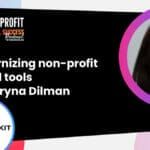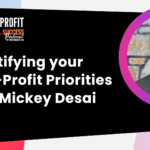Video recording
Audio recording
In this episode, we dive deep into the digital world with Sarah Suarez, a seasoned expert in engaging digital audiences.
With nearly a decade of experience in both small and large non-profits, including the Houston Humane Society and the Museum of Fine Arts, Houston, Sarah brings a wealth of knowledge. As the founder of the Social Puzzle, she’s dedicated to helping non-profits and small businesses boost their online presence. Join us as Sarah shares her insights on creating effective social media strategies that resonate with audiences and amplify your mission.
Tune in now and unlock the potential of social media for your non-profit!
Mentioned Resources
Episode Transcription
David Pisarek: How are you using social media for your non-profit and charity? Hang out? Listen to this episode. I’ve got Sarah on the show, and we’re going to talk all things social media, so pay attention.
Sarah Suarez: I thought it was great.
David Pisarek: Welcome to the Non-profit Digital Success Podcast. I’m your host, David. And in this episode, we’re going to be talking all things social media with Sarah Suarez. Sarah has nearly a decade of experience at small and large non-profits, including the Houston Humane Society Museum of Fine Arts, Houston.
She’s the founder of the Social Puzzle, which is a boutique social media agency that builds and engages digital audiences for non-profits and small businesses so they can focus on increasing their impact. Sarah, thank you so much for joining on the episode today.
Sarah Suarez: Thank you for having me. I’m really excited to chat with you.
David Pisarek: Fantastic. And just like off the bat, you mentioned that you are an introvert. So this is like something really different and neat, and you’re working on expanding your personal growth, I guess. How does this feel for you?
Sarah Suarez: It feels better than my first one. This is probably my third time sort of showing up in this capacity, and the first time I probably didn’t sleep the whole week before, but this time I slept last night. So it’s improvement.
David Pisarek: Fantastic. And you’re in a family of extroverts. So what’s that like?
Sarah Suarez: Exhausting. They don’t have a need for downtime or they recharge by constantly talking to me. And so as an introvert surrounded by extroverts, it’s difficult to get that recharging time, but it’s also helping me to sort of get out of my little introvert shell.
David Pisarek: Yeah. Sometimes we need to do things that push our boundaries a little bit. And I find for myself, when you find that boundary, you’re like, “I feel a little uncomfortable.” That’s when you know you’re growing.
I think it’s important for people to think about this idea of personal growth, but expand it to the organizations that they’re working at. Right. If your manager, director, or executive director is like, “I don’t think we should be doing stuff on Twitter”, let’s try it. Let’s see what happens. Let’s experiment a little bit with that.
Sarah Suarez: Yeah, I completely agree. And really, there’s not so much risk if you’re being careful, if you’re doing it thoughtfully, there’s more to gain, for sure.
David Pisarek: Speaking of gaining, what do you see as the biggest opportunity that non-profits might be missing out on when thinking about social media marketing?
Sarah Suarez:
So for the organizations that either have not yet found their place on social media, not created a presence, or for the ones that maybe have pulled back, the biggest thing I think that they are missing out on is reach.
So the potential to connect with either donors or even strategic partners that could help expand their mission and maybe outside of their physical location.
I have a client that, through relationship building on social media, established a strategic partnership that has allowed them to expand their reach globally outside of the US. And that’s really been a game changer to them. They wouldn’t have had that opportunity if they hadn’t been active on social media.
David Pisarek:
I have a workshop webinar, that’s all about how to get corporate sponsors for your non-profit or charity. And one of the things that I talk about is connecting with these potential strategic partners, potential corporate sponsors, and commenting on some of their posts, not necessarily just outreach. “Hey, do you want to connect and donate and volunteer with us?”, but start creating some conversation with them in a space that isn’t just about asking.
Sarah Suarez: Yeah, for sure. And I think obviously that’s all part of being social. On social media is like building these, as authentic as they can be relationships with, whether it’s other organizations or if it is a potential corporate sponsor.
I volunteer for an organization, and I am the co-sponsorship chair for their walk, their annual walk. And I can’t tell you how many times they ask, “What platforms are you on? What’s your handle? How many followers?” Because it also provides them an opportunity to get in front of your audience. And they want to quantify that by seeing how much of your audience there is.
David Pisarek: Exactly. There’s a reciprocal relationship that needs to happen there in order for it to be successful.
Sarah Suarez: Right? Yeah.
David Pisarek: Non-profits typically operate, I hate this saying, but on a shoestring budget, usually understaffed, usually well overworked people are doing the job of two, three, four people sometimes. What do you recommend for smaller non-profits who might not be able to afford an employee or even find a volunteer to kind of manage their social media? What do you recommend for them?
Sarah Suarez: Well, I think a few things.
One, it’s so important to show up, and really, if you have no social media presence, it doesn’t, in my opinion, reflect well on your organization, saying that you’re a modern non-profit.
The other thing I would say is the person who is running your social media really needs to have an understanding of your organizational goals and use those goals to create and implement a strategy on social media. And so that may not always be possible when a volunteer or an intern is managing your presence.
But I think what I would recommend in that situation is that the organization make a small investment, a one time investment with a social media professional that either provides an audit so you can see what’s working, what’s not, and get suggestions for improvement, or even better, a customized strategy which will serve as a roadmap for the volunteer or intern.
And the best thing about that is in the case of turnover from volunteers or interns, there is going to still be a consistency in your presence. It won’t be like the tone changes or the vision changes. It will always hopefully maintain the same feel because it’s based off of this roadmap, this strategy.
David Pisarek: And that ties into something that I’ve spoken about on a number of other episodes, which is branding. When you think of your brand, you think of your logo, maybe you think of your colours. Quite often you don’t really think about your font or your tone or style of messaging. And when I meet with our clients, I talk about maybe you should create a content style guide or an editorial style guide. Create a social media style guide, have things like what is okay, what isn’t okay, right?
I’ve seen in the past some flame wars where I think like Dairy Queen tries to go after Burger King across the street and they post signs up trying to challenge each other and stuff like that.
If something like that is okay for your organization, that needs to be documented.
So whoever is managing the social knows what those boundaries are that are maybe okay to push a little bit further.
Sarah Suarez: Right? Yeah, I agree.
And as an example, I have a client and their tone is just very upbeat, positive, encouraging. They would never experience sort of, “I have never seen them experience trolls.” And then I have another Organization that has experienced trolls.
And so after talking and running the possibilities by everyone, what we come to the conclusion of is that we want our social media space to be a safe place. And so if there is any negativity towards other followers or audience members, we just basically delete it because it’s not worth bringing that to the forefront.
But that was an important decision to make at the beginning, so that there was an understanding of how it would be and an expectation of how it would be.
David Pisarek: And things like that would be covered under, let’s say, an acceptable use policy or guideline document that you might have on your website saying that you reserve the right to remove X, Y and Z without notification, for example.
Sarah Suarez: Right.
David Pisarek: Okay. So potentially hiring somebody as like a one-time shot, get some clear strategy for your organization, and potentially doing some outreach, finding somebody that cares, that’s passionate about your organization, maybe leverage them and see if they are comfortable helping you with your social media. I think those are some interesting opportunities, but being very clear on what’s okay, what isn’t, and the tone is super important.
Sarah Suarez: Right.
David Pisarek: All right, so I’ve had conversations with guests before around this topic. I’m curious what your thoughts are. What is the best platform for a non-profit to focus on?
Sarah Suarez: So that is tricky because I really think it depends on the organization and the audience they’re trying to reach.
And then once you understand your audience, you kind of know what platform they’ll hang out on, and that’s where you should focus.
That being said, all of my clients are on Facebook and Instagram because the meta fundraising tools are just game changers. I have a small non-profit that it is not uncommon for them to bring in a month from birthday fundraisers. And so even though maybe the engagement isn’t great there, it takes a lot more work to sort of get it up to the level of other platforms. The fact that their audience, that their supporters have the opportunity to fundraise for their mission without them having to do anything is just almost too good to pass up.
David Pisarek: I’m so happy that you said that there isn’t a one size fits all for everybody. If your organization is targeting a younger audience, chances are you want to be on a platform like TikTok. Maybe you don’t want to be on Facebook. Facebook is trending older age groups year over year.
But one of the things you said is, what do they care about? And what I want to encourage everybody to do… Once you’re done listening to this episode, go and listen to episode 16 of the podcast. I talk about specifically what are psychographics and why should you care about them for your non-profit?
And so we know what demographics are. I think that’s kind of obvious.
We know what geographic is, psychographics is, what are the interests, what do they care about? What’s happening inside their head? How can you connect with them emotionally? Where are they hanging out? What are they spending their time doing?
And leveraging that you’ll be able to figure out… All right, in the business world, we talk about, like a client, a customer, right? So if you think about your audience in terms of customers, where are they spending their time, and how can you work, your way in there to connect with them, where they’re already spending time?
Sarah Suarez: Right. And kind of to touch back on what I already said about Facebook. Or it might be that you’re on a couple of platforms in that both serve different purposes for your organization.
So if you have a younger audience, you might get more engagement on TikTok, but you might have very low engagement on Facebook or Instagram and still be bringing in fundraising for birthday fundraisers or even if you set up a fundraiser. So it’s kind of like knowing where they are and understanding the possibilities and expectations that should be set for that platform.
David Pisarek: Absolutely. And I guess this leads into the next question, which is, how often should you be posting to social?
Sarah Suarez: Yeah. So that, in my opinion, is all about bandwidth. So I would say a minimum of two to three times a week, but it’s really also not burning yourself out.
So I know a lot of smaller organizations either don’t have the staff in place or the budget to pay someone to be doing it every day. And I think it’s more important that you show up consistently over time than to show up all at once and then burn yourself out and disappear. And that happens. I’ve seen it happen, and that really is not going to serve your mission.
David Pisarek: One of the things that I wish, and I hope that people listening to this episode do, is look at the content they’re already producing on their website. A blog post, you can easily turn that into four, five, six different social posts, and then you can spread that out over a two-month period.
It’s really easy. You’re already producing great content. Maybe there’s a news release, maybe there’s a new program or a service that you’re offering, or maybe you’ve expanded and you’ve opened up a new location somewhere. Or maybe there’s an art Show. You can take pictures of the art, right? And you can turn all that into really amazing content.
Sarah Suarez:
You know what my absolute favorite thing is? As a social media content creator? I do write blogs sometimes, and oh, my goodness, I love an annual report. It’s just like endless content.
So, yes, repurposing existing content is the way to go, for sure. And the way to avoid burnout.
David Pisarek: What do you see as some of the biggest no-no’s from non-profits on social?
Sarah Suarez: So I would say that the two biggest no-nos that I seen, they really go hand in hand. And that is that organizations either never ask for money, which I have this issue with some of my smaller clients that either have a new ed or they’re just a newer non-profit and they’re not used to making ask and there’s a mindset issue there that needs to be addressed, or they’re making ask in literally every post.
And so I feel like it’s so important to have a strategy and build your request for giving into that strategy, and if they can be a part of a larger campaign, even better. So I think really understanding the importance of incorporating fundraising into a larger strategy and not either ignoring it or doing it every day,
David Pisarek: I think that’s really great. Leveraging social to talk about the impact in how the donor dollar or the volunteer hours or the incline donations that you receive, how are those helping and where is it being spent? Helps build the case for support.
Sarah Suarez: Right?
David Pisarek: So leverage that you’re out there doing amazing things in the world, talk about it. And then when you go to ask if you’ve got followers on social, they understand, they’re empathetic, they engage, they’d be more willing to give you because they know what’s happening with it.
Sarah Suarez: Right? Exactly.
David Pisarek: All right, so we talked about easy ways to create content. How many times you should be posting. What do you find is the biggest benefit to having a social media presence for non-profits?
Sarah Suarez: We’ve kind of touched on this already. I really think it’s social proof.
I mean, obviously there’s benefits in terms of the fundraising capabilities or building a great digital community, but it serves as this sort of like living document documentation, I should say, of your social proof.
If you’re sharing stats from your latest in your report or videos and photos of client success stories a day in the life of your ED, I think that those things will all document your work towards your mission and share your impact. So I think that it’s often overlooked that even greater than all of the little pieces combined, social media can serve as this social proof that you are doing what you’re saying you’re doing.
David Pisarek: I love that. I think that’s so great. It builds confidence in your organization. And the social proof is huge. It doesn’t instantly lead to social proof.
Sarah Suarez: Right.
David Pisarek: You need to be spending time on a consistent, regular basis, putting in the effort, and it will happen. You need to believe in that.
Doing three posts a week for a month and going, “Oh, we have four followers.” What do you feel in terms of how long, how much effort, how much time should people be putting in before they maybe look for an expert like yourself?
Sarah Suarez: So I think that it’s just like with anything else, success is not going to be overnight. And the longer you’re in it, the more you sort of get an understanding for your audience and how to speak to your audience directly where they want to engage, but I feel like it also depends on your organization.
So one of my clients is super niche, and they have a small following, but their following is incredibly engaged and they have a really high engagement rate. And everyone, I would like to say 90% of their followers are not… It’s very common to get a bunch of bots now, like with social media, but 90% of their followers are other organizations or other individuals that are really interested in their mission and really engaged in their mission, but they’re not going to skyrocket to tens of thousands of followers. It’s just not going to happen for them because they are so niche.
Now, if you have, like, a shelter, that’s going to be easier to grow because everyone loves puppies, everyone loves the idea of saving animals. So you have to consider what is possible for your organization and sort of create your expectations around your specific organization.
David Pisarek: One of the things that you mentioned is bots. Can you talk about what bots are and maybe how somebody might be able to understand or identify if one of their followers is a bot?
Sarah Suarez: Right? So I hate bots. Bots are basically fake accounts that maybe follow you. I notice that they follow, and then they like, like ten of your posts, or maybe they’re the ones that comment, like DM this to this community or something like that. And they are not an actual individual or organization that really cares about your mission.
So I try and consider that there’s going to be a percentage of bots within any following that has to be considered when you’re thinking of how large your following is, but also, I don’t waste my time on engaging with them.
And something that I’ve had to kind of work on with some clients is that this is the reason we don’t do the follow and follow game, or we don’t follow every organization or every individual that follows us.
Because not only is it not the best strategically in terms of creating your online presence, but they could be bots, they could be fake people. So in general, I either like to ignore them or squash them with the hidden word so they can’t even comment or their comments don’t show up.
David Pisarek: What you can also do is you can block them, you can kick them off of following you, right? So it’s important to spend a bit of time culling your list, looking through your list, identifying maybe donors or volunteers that work with you in the real world versus the digital world. And if you can identify them there, maybe you can engage with them in social.
Sarah Suarez: Right.
David Pisarek: One of the things that we know is true is as you engage with people, ideally real people, instead of these bots. And you have conversations, and if somebody posts a comment, if you reply sooner, the algorithms go, “Oh, this is a real account. Somebody cares about this”. You’ll be seen by more people over time.
So you do want to make sure that you’re checking your notifications. If you can get the notifications by email, that might help because maybe you don’t have social open or notifications. It ain’t old or your phone’s on silent or something like that. Try to reply as soon as you can to those messages that come in.
Sarah Suarez: Definitely. And another thing I like to do with bots is report them. I just hope over time they’ll get enough reports, and I’m just a little help towards getting it kicked off.
David Pisarek: That’s awesome. One of the words that I hear quite a bit about is digital communities. Can you talk about what that is and how non-profits might be able to leverage them?
Sarah Suarez: Definitely. So I use that term to speak kind of broadly about any individual or organization that also might support your mission. Could be similar organizations, donors, volunteers, and one that I think is often overlooked, which is just like a simple advocate.
Someone maybe isn’t donating to your organization or volunteering, but they will share your post and comment and engage. And that really helps with spreading awareness. So I think even that is part of the community is super important.
And what non-profits can do to sort of leverage that is consider that when these advocates are sharing your post, that is amplifying your mission to people who would not see it.
And I think what you can do to encourage that behavior is use a good call to action. You can say, “Share this with someone who needs to hear it today”, or “Tag a friend who might be interested in attending our event.” And what it really does is help you get out in front of more people.
And I think that it’s not really valued as much as it should be because it really can make a difference for your organization in terms of who knows about you so they can want to get involved.
David Pisarek: One of the terms that kind of gets thrown around a little bit is the couch surfer, right? That’s somebody who’s sitting on their couch.
They’ve got a remote in one hand, whatever streaming service or cable or whatever it is, right. And in the other hand, they’ve got their phone, and they’re kind of paying attention a little bit to both make it easy for them to just share your stuff right on your website.
If they’re maybe flipping around, have a share to social link on there. There’s lots of platforms that “Share this.” There’s a bunch of them out there.
Super easy to put in your site, but on social, to your point, Sarah, identify the people that are sharing your stuff. Try to engage with them, try to have some kind of conversation, maybe shoot them a private message, a DM, and be like, “Hey, I saw Sarah. So great. Thank you for sharing our posts. Super awesome that you’re able to do that. Would love to connect and talk maybe and see, if not even for money, not even for time, but just thank them for being an advocate.”
Sarah Suarez: Exactly. And my background is in stewardship, so that is something that I am super excited about is the opportunity to thank anyone that is helping your organization in any capacity because it matters. And when they feel seen, they’re more likely to want to advocate for your organization further when they feel seen and appreciated.
David Pisarek: Absolutely. And put your name on the post, even if it’s just like, if you’re sending a private message to somebody, “Hey, Sarah, thanks so much for sharing the post. DP” at the end of then, like, maybe there’s some privacy stuff so you don’t want to give your actual name or whatever on social, totally fine. But put the initials there or something like that. It does create a sense of personal connection.
Sarah Suarez: Right. It humanizes it. And humans want to connect with other humans, so it’s good for them to know that this is either staff member or a volunteer that really appreciates what you’re doing for the organization.
David Pisarek: Absolutely, Sarah. These have been some amazing insights around social media.
I hope that people listening to this episode get some really great advice. I want to give people a challenge coming out of this. Is there anything that you want to challenge somebody to do within the next two or three days of listening to this episode?
Sarah Suarez: I think if they can consider their social media presence for their non-profit, if they have one, and look at it and determine if they have a strategy, and if not, even if they don’t have the ability to build a strategy right now, I think it would be great if they could maybe consider that, consider what their goals are when they’re creating their future post. So just think more of strategy.
David Pisarek: That is awesome. All right, everybody, you heard it here from Sarah. Think about strategy. The worst thing you can do is just do nothing, right? Sarah, if anybody wants to get in touch with you, what do they need to do?
Sarah Suarez: So you can find me on Instagram at @Social.Puzzle. You can also go to my website, thesocialpuzzle.com and my email is on my website. I am always checking my email. I’m always checking my DMs. So I’d be happy to hear from anyone.
David Pisarek: It’s important, right? Working in social media, checking your DMs. Love that.
Sarah Suarez: All the time.
David Pisarek: And we were talking just before the episode. You have a little gift for listeners, right?
Sarah Suarez: So I have a free 30-day content calendar for non-profits, and it gives you four example pillars. And then basically, if you’re posting five times a week, it gives you post ideas for each of those posts.
David Pisarek: If you want to take that 30-day thing one step further, spend the time, knock it out. You’ll have your content planned for the whole year, and it’s easy sailing after that.
Sarah, thanks again so much for joining in. It’s been great having you on the Non-profit digital success podcast.
Everybody listening, if you want any of the links or the resources that we spoke about, just head over to our podcast page nonprofitdigitalsuccess.com. Click on this episode for the details.
And until next time, keep on being successful!














0 Comments